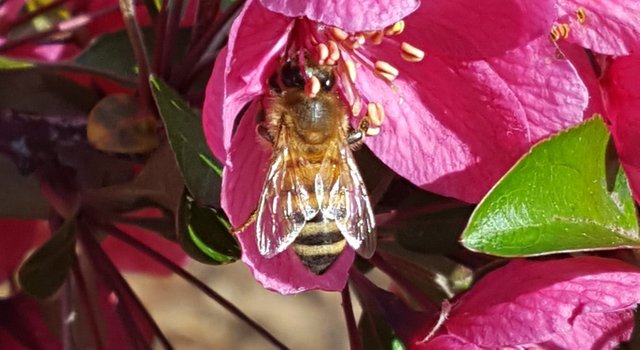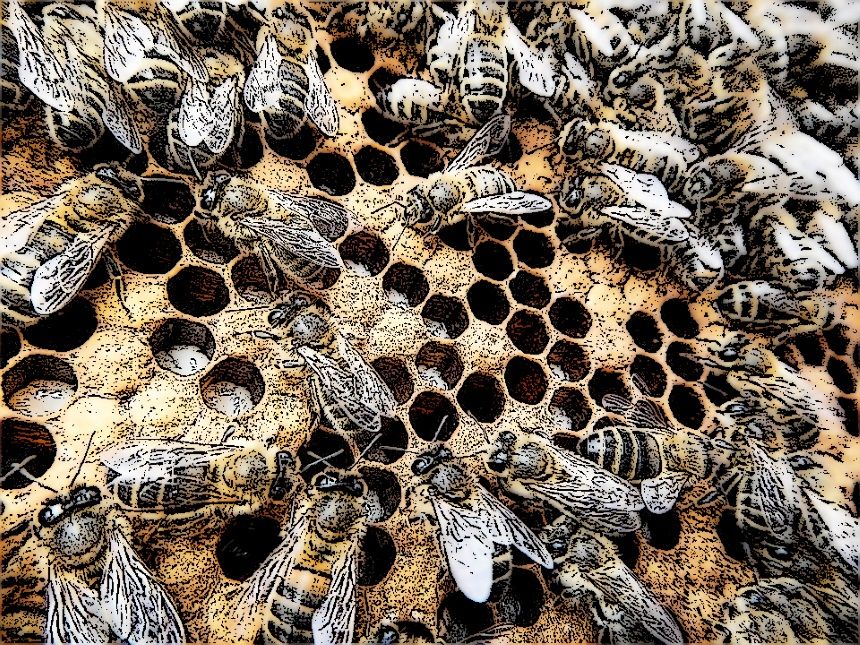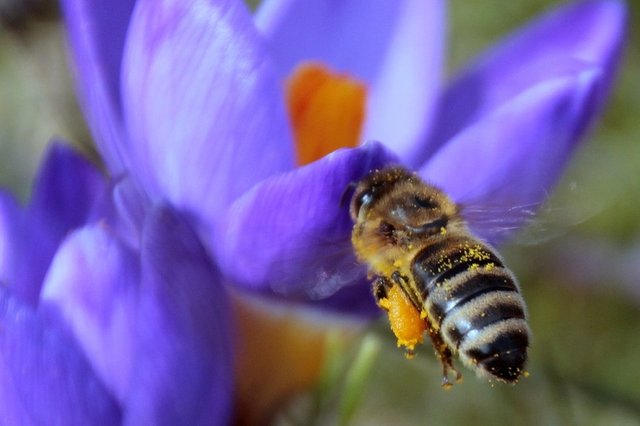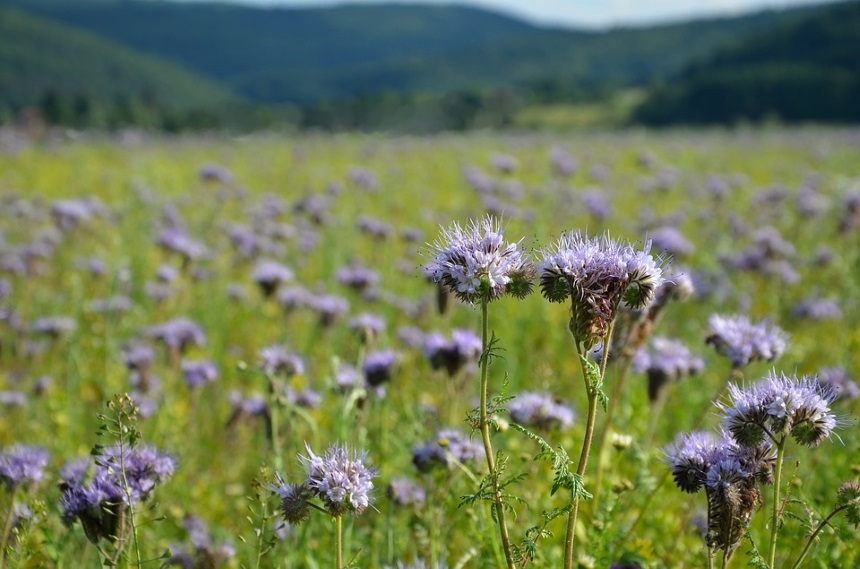Learning the Art of Beekeeping -- Part Five
The following is a small excerpt from my previously published book, The Beekeeper's Guide.
Three Makes One…Continued
In our last session, we learned about the hapless drone, now we move on to the worker bee—the true star of the hive.
The Worker
The mighty worker bee may be the smallest in size but does the lion’s share of the work in the colony. Most of the colony will consist of worker bees. If there are 50,000 bees in one colony, there will be one queen, maybe 500 drones and the rest will be worker bees.
The industrious little worker bee starts her life off as an egg in a honeycomb cell, just like the queen and the drones. At three days, she becomes a larva and at 9 days her cell gets capped. On the 21st day, she emerges and her life of work begins immediately. The first chore is to get her brood cell clean. I sometimes wonder if one of her sisters walks by and says, “Mom said to make your bed and clean your room.” Whatever mechanism clues her in, it seems to work well. She spends the first day or two cleaning her cell and others around the area. The queen will not lay another egg into a brood cell that isn’t perfectly spotless. So if it doesn’t get done right, the workers must clean it again until it passes inspection.
Days 3 through 11, in the worker bee’s life, are spent feeding bee larvae. The nurse bee, as it is referred to during this stage, feeds worker jelly to worker larvae. During this same period of time, if there are any drones or queen bee larvae that need to be fed, they will receive royal jelly. Queen larva get only royal jelly, drones get the good stuff for just three days. The workers produce this royal jelly and the worker jelly with the same glands.
On the 12th day, the humble, busy little worker bee begins to produce wax. It will spend until day 17 building new honeycomb, repairing old honeycomb and capping stored honey and pollen as well as capping larva that are ready for that event. The wax is produced from four sets of wax glands that are found in her abdomen. If you look carefully in your hive, you will see some of the bees have flakes of wax on their bodies. This is normal. As the wax is produced, it forms in small flakes on the worker bee’s body.
The next few days, up until day 22, are spent defending the hive. The guard bees stand in the entrance of the hive and check the scent of every entrant. Any who try to enter without the hive smell will be attacked. This can include bees from other hives, flies, hornets, wasps, and even you if you don’t enter the hive properly. We’ll discuss opening the hive a little later. For now, be reassured that if done properly, the defenders of the hive will not be able to do you harm.
Other activities that the worker bees will engage in during their lives are:
Feeding drones (the lazy guys can’t even feed themselves at first and don’t start feeding themselves until older),
Care for the queen by feeding her, cleaning her, and collecting the critical Queen Mandibular Pheromone that seems to manage the hive.
Seal mature honey in cells. This wax cell, or cap, prevents the honey from absorbing moisture from the air. Because honey is hygroscopic, it will absorb moisture from the air. High moisture content will ferment and spoil the honey. To prevent this, the bees seal the honey with a bit of wax called a cap once the honey gets to the perfect moisture content.
Collect wax to build and repair honeycomb.
Pack collected pollen firmly into honeycomb and mix it with just a touch of honey. The honey keeps it from spoiling.
Act as morticians by removing dead bees and larvae from the hive. This obsession with cleanliness keeps the hive safe from diseases.
Fan the hive to keep it cool and to help the honey reach the perfect state of moisture content.
Propolize the hive. Propolis is a resinous substance that the bees collect from plants and mix with enzymes from the bees. Propolis has antibacterial as well as antifungal properties. They basically use it to glue up any cracks and crevices in the hive walls.
Carry water to the hive. They spread this water onto the backs of the bees that are fanning. The fanning bees become miniature evaporative coolers; this helps the hive stay cool.
On the 22nd day, the worker bee graduates into a foraging or field bee. As a forager, these bees are responsible for finding and bringing nectar, pollen, water and resin for propolis into the hive. Amazingly, bees can travel up to 1.5 miles to find these important items. Of course, if they can find it closer, they will. Her life ends when her wings are literally worked ragged and she becomes unable to fly anymore. When this happens, she usually is unable to return to the hive and perishes soon after. A sad end for our noble little worker.
*While this timeline for the worker bee is accurate, depending on the needs of the hive the individual workers may spend more or less time doing certain activities.
The worker bee has a busy life. Every single moment of it is spent working for the good of the hive. Let’s talk for a moment about her role as defender of the hive.
The worker bee has a stinger with a barb. When she stings a mammal, the barb catches under the skin and stays in place. As she pulls away, her abdomen tears open and the venom bulb stays hanging from the barb. During this event, an alarm pheromone is released by the Koshevnikov gland. This alarm alerts nearby sisters to come and join the defensive effort. The pheromone will encourage other bees to sting. The venom bulb attached to the stinger continues to pulse and push more venom into the victim until it is empty or removed. The bee, broken and torn, dies from her effort to defend her sisters. The barb is constructed in such a way that when a bee uses it on other insects, it doesn’t get stuck. So invading insects beware, you will be stung many times and no bees will be harmed in the process.
A few interesting facts for you to consider as you think about the worker bee:
• She will visit about 1500 flowers to collect a full load of pollen. A full load weighs about 10 mg.
• The colony must produce approximately 500,000 flakes of wax to equal one pound of beeswax
• She will produce approximately 1/12 of a teaspoon of honey during her entire life.
• She flies about 15 miles per hour.
• One ounce of honey would give a single bee enough energy to fly around the world, if only she could fly that far.
• She and her sisters will visit about 2 million flowers to produce a pound of honey. So be appropriately grateful, when you get 100 pounds of honey from your hive, they have visited upwards of 200 million flowers to give you that wonderful gift of golden joy.
Bees live their lives in stages. When first laid, they spend the first three days as an egg. As an egg, they subsist on the yolk in their individual egg. From there, they hatch into a larva. During their short period of time as a larva, they stay in the honeycomb cell they were laid in and eat and are nourished by the worker bees in the hive. The first three days as a larva they are fed royal jelly. After this, the worker bees begin to receive bee jelly, honey and pollen—sometimes referred to as bee bread. During this stage of growth, amazing things are happening to her body. She grows to a size 1500 time larger than when she was first laid as an egg by the queen. During this period of time, all bee castes molt nearly every 24 hours. They will molt five times as a larva. At the appropriate time, worker bees come along and cap the cell with wax. Sealed in her wax chamber, the larva spins herself into a cocoon and becomes quiet and still. On the 20th day, she has her sixth molt and is now considered an imago (adult) bee. The next day she chews her way out of her wax cell and emerges ready to work in the hive.
My book, The Beekeeper's Guide, is available for purchase on Amazon right here.
© 2015, Stone Golem Publishing, All rights reserved--no part of this may be used without express written consent.
**The first picture is mine, all the following pictures are from Pixabay and marked "labeled for reuse". I did alter a couple of them just to add a bit of visual interest.
Follow @bigpanda for more flash fiction and homesteading tips.





I think some people could/should take this into consideration... as I know many LAZY people.
Work, do chores and be responsible. Even at only a moment old, this gal knows what needs to be done and does it!
I love what a great example she is to all of us humans.
Sounds like the worker bees need a raise, lol
Nice information dude . well done keep it up.
hey @bigpanda your story " The Hunt "
Is incomplete ......
Beekeeping is interesting!
I quote a little bit about
Bees live their lives gradually. When first laid down, they spend the first three days as an egg. As eggs, they live with egg yolks in their respective eggs. From there, they hatch into larvae. During their short time as larvae, they live in the honeycomb cells that they occupy and eat and are fed by worker bees in their nests. The first three days as larvae they were fed royal jelly. After this, worker bees start receiving bee jelly, honey and pollen-sometimes called bee buns. During this stage of growth, amazing things happen to his body. He grew to a size 1500 times larger than when he was first put as an egg by the queen. During this period, all deer bee almost every 24 hours. They will whim five times as larvae. At the right time, worker bees come and cover the cell with a candle. Sealed in his wax room, the larva spins into a cocoon and becomes silent and silent. On the 20th day, he has the sixth feather and is now considered the imago (grown) bee. The next day he chewed his way out of his wax cell and appeared ready to work in his nest.
A very great post @bigpanda, this is very useful for us all. thanks for sharing a very interesting post.
send regards for success.
Natural photos that learn us how to industrious. Great job. Keep sharing.
Great work! Thanks for sharing!
Such a nice information about honeybee thanks for sharging with us and the first image was really awsome i hope you take that shot
Again, great post. It is a truly pleasure to read your posts. Here again, how amazing the bees life are? wow. And omg drones are the worst. Great post dear friend.
One queen bee is escorted by 50,000 bodyguards. Workers bees are also very loyal to the queen. Thank you for sharing knowledge about bee cultivation @bigpanda.